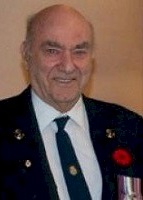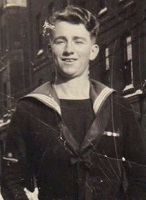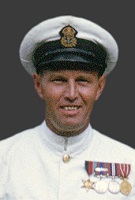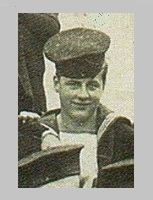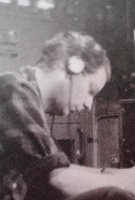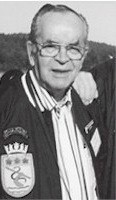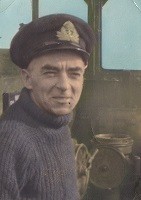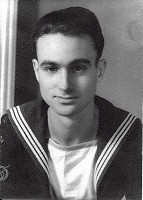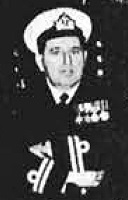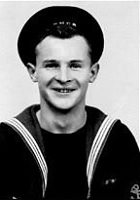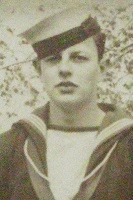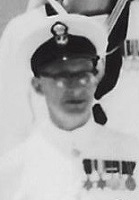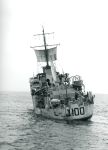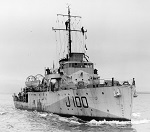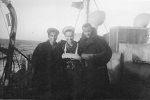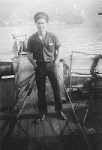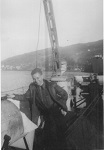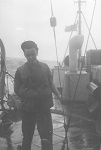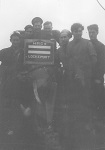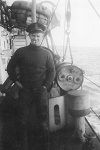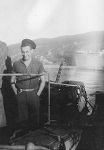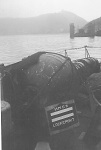|
HMCS LOCKEPORT J100
Bangor Class Minesweeper
Built for the RN by North Vancouver Ship Repairs Ltd., at Vancouver but transferred to the RCN for manning. She was commissioned on 27 May 1942, and served with Esquimalt Force until 17 March 1943, when she left for Halifax. On her arrival there on 30 Apr 1943 she was assigned briefly to WLEF and, in Jun 1943, to Halifax Force. In Nov and Dec 1943, she was lent to Newfoundland Force but was withdrawn owing to engine trouble. On 09 Jan 1944, while en route to Baltimore for refit, her engines broke down in a storm, and she made 190 miles under improvised sail before being towed the rest of the way to her destination.
The story of HMCS LOCKPORT'S miraculous trip under sail appears to be more than wartime propaganda than actual fact - at least according to one LOCKEPORT sailor, Bill Tom. "My name is Bill Tom. I was an Able Seaman on the minesweeper Lockeport, that served in World War II. One of my experiences was involved with a headline that appeared in the Toronto Daily Star on Wednesday, May 3rd, 1944. The headline was "Hammocks for Sails: Canadians Bring Sweeper Home." And then there was a sub-headline, "Engines are dead but Canadian sails sweep her in." My true account of this was completely different than what appeared in the Star. We actually sailed from Halifax in the spring of '44 under normal seas for that time of year. And about 250 miles off New York, our fan engines broke down and, as a result, we were unable to operate the main engines, and so our ship lost power and so there was considerable apprehension, of course, because we had no power and we wouldn't be able to defend ourselves against any enemy submarines that were in that area. So, the weather started to get a bit rough and to compensate for this, we tied together some canvas and some wood and bits of odds and ends, bound them together with rope and threw them over the stern of the ship and tied them to the stern. This acted as, what they call, a sea anchor to keep the bow of the ship heading into the wind. We also took the sail out of the lifeboat and attached it to the rear mast of the ship. And, again, the function of this was to keep the bow into the wind. Another problem that we did have was that, when we sailed for Philadelphia and we were actually going to Philadelphia and then up into the Port of Baltimore for a refit, which is like a major overhaul of a car, generally with a ship it took about two months. So it was a three-day trip and, because we were going to be stationed in a foreign port, the orders were to take all the food off the ship, leaving us enough for the three-day trip. Unfortunately, when our engines broke down, it was obvious that we were going to be at sea for longer than a three-day trip. So, rather quickly, we ran out of food. This created a bit of a problem. And also because we couldn't operate the fan engines, we were unable to make fresh water from sea water. And so there was a... a lack of water, also, on the ship. It took us to the tenth day into the trip before we were picked up by a Coast Guard tugboat. Again, this was a bit of a problem because the sea was getting a bit heavy and it took us three attempts to get the towrope fixed to the tug. One of the things that we did have, and it was sort of a celebration, was that they did bring us in a very large container of stewed tomatoes. Ordinarily this would not be excellent fare, but when we hadn't had too much to eat, only hardtack and water, this was almost like having a Christmas dinner. Hardtack is about a three-inch diameter hard biscuit. And when I say hard, it's... it is quite hard. So, when we got towed into Philadelphia there was a tender that came out from shore and brought us out some crates of fresh bread and some pounds of butter. So we all sat around the mess eating fresh bread and butter. When we got back to Halifax, they asked us one day to take our hammocks up to the foc'sle of the ship on the deck and to sew them together and then we hoisted them up onto the yardarm of the main mast and steamed out into the harbour of Halifax. None of us knew, really, what was going on. We noticed that there was a couple of tenders cruising alongside us and people taking pictures of us as we were going along with this rather large sail attached to our yardarm. A few weeks later I got a letter from my dad admonishing me for not informing him of this horrendous experience we had. He sent me a copy of the... The Star describing how we had sewn our hammocks together and sailed the ship into port. The next time I was home on leave I was able to inform my dad that this was all a PR stunt on the part of the Navy. That the only time we ever sewed the hammocks together was when we were in the Port Halifax." (Source: The Memory Project / The Canadian Encyclopedia)
Upon her return to Halifax in Apr 1944, LOCKEPORT was ordered to Bermuda to work up, and on the homeward journey she escorted the boats of the 78th Motor Launch Flotilla. Returning to Sydney Force in May 1944, she was frequently an escort to the Port-aux-Basques/Sydney ferry. She left Canada on 27 May 1945, for the U.K., and was returned to the RN at Sheerness on 02 Jul 1945, to be broken up three years later at Dorkin, Gateshead.
Photos and Documents Ship's company photos
Commanding Officers
They shall not be forgotten
Former Crew Members
Photos and Documents
(BH04) Newspaper article on minesweepers clearing the approaches to St. John's, Newfoundland. Ships mentioned: HMCS SARNIA, HMCS STRATFORD, HMCS LOCKEPORT, HMCS MEDICINE HAT, HMCS GRANDMERE, HMCS VEGREVILLE, HMCS CANSO, HMCS BURLINGTON, HMCS CARAQUET and ML Q091 is the Fairmile mentioned that towed in the mines.
Sailors mentioned: Lt George Rundle of Montreal, QC; PO J.W. Wells of Grand Bay, NFLD and Lt George Gordon McClelland ML Q091
(BH05) HMCS LOCKEPORT pennant (BH06) Sailors on HMCS LOCKEPORT. Bert Honer standing, 2nd from left (BH07) Sailors on HMCS LOCKEPORT. Bert Horner, 1st on right (BH08) Bert Horner on HMCS LOCKEPORT at St. John's, NFLD
(BH09) HMCS LOCKEPORT departing St. John's, NFLD (BH10) Unknown sailor on HMCS LOCKEPORT (BH11) Unknown sailor on HMCS LOCKEPORT (BH12) Bert Horner on HMCS LOCKEPORT (BH13) Unknown sailors on HMCS LOCKEPORT
(BH14) Unknown minesweeper seen from HMCS LOCKEPORT (BH15) Unknown CPO on HMCS LOCKEPORT (BH16) Unknown sailor on HMCS LOCKEPORT (BH17) Minesweeping gear on the sweep deck/quarterdeck of HMCS LOCKEPORT (BH18) Unknown sailor on HMCS LOCKEPORT
(BH19) Quarterdeck of HMCS LOCKPORT. Unknown vessel in drydock at St. John's, Nfld - Signal Hill in the background
From the collection of Bert Horner, RCNVR
Courtesy of Bruce Horner
|
|||||||||||||||||||||||||||||||||||||||||||||||


